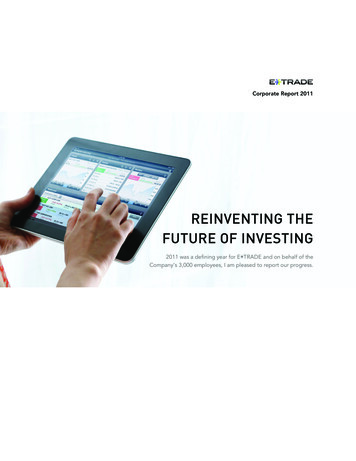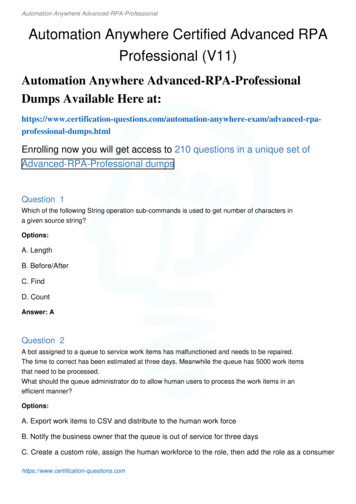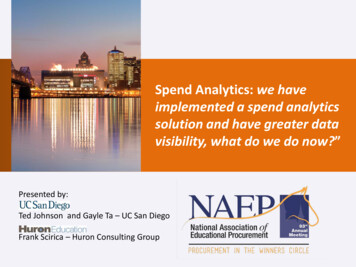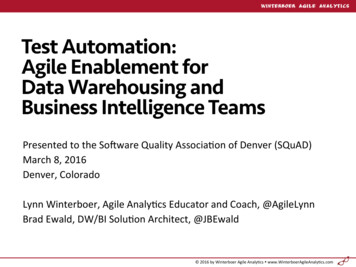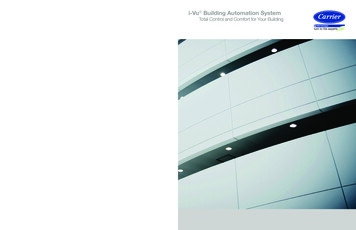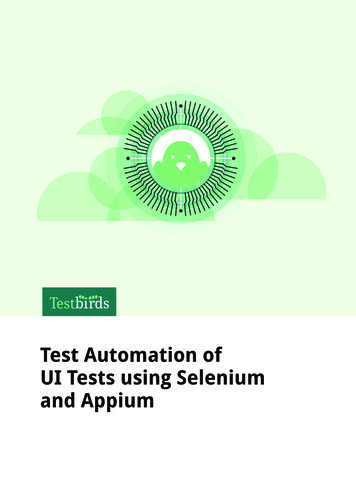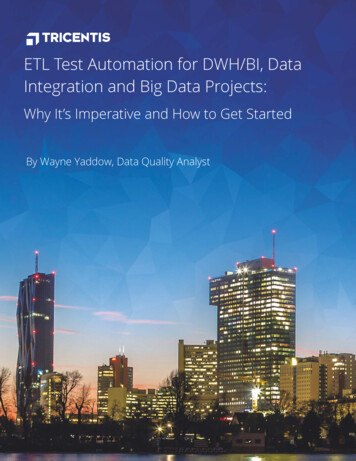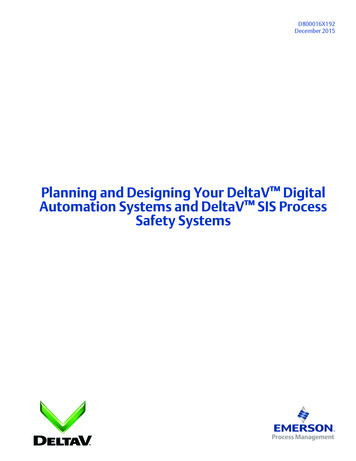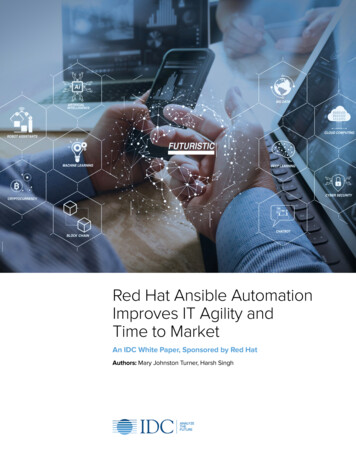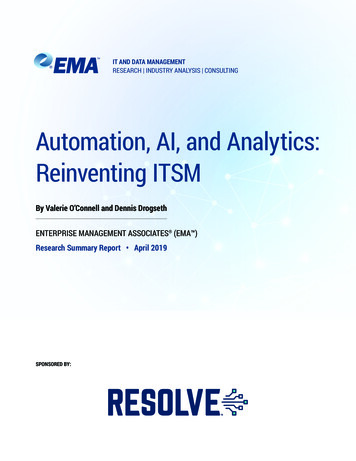
Transcription
IT AND DATA MANAGEMENTRESEARCH INDUSTRY ANALYSIS CONSULTINGAutomation, AI, and Analytics:Reinventing ITSMBy Valerie O’Connell and Dennis DrogsethENTERPRISE MANAGEMENT ASSOCIATES (EMA )Research Summary Report April 2019SPONSORED BY:
Automation, AI, and Analytics: Reinventing ITSMExecutive Introduction .2Demographics and Organization .6AI/AIOps and Analytics.6Looking at Actual Deployments for AI and Analytics.7Automation. 8Virtual Agents and AI Bots. 11Success Factors.12Enterprise Service Management (ESM).13Conclusion.152 2019 Enterprise Management Associates, Inc. www.enterprisemanagement.com
Automation, AI, and Analytics: Reinventing ITSMExecutive IntroductionEMA research consistently tracks IT service management (ITSM) as a hub of digital transformation and change.What’s new are the ways artificial intelligence (AI), automation, and analytics are redefining ITSM’s role inbusiness innovation, services, and organizational reinvention. Although potentially game-changing, theseadvances are not challenge-free. Technological complexity, functional understanding, resource allocation, andsimple resistance to change all exert a drag on adoption.Part of the challenge comes from confusion around the technologies themselves, since vendors and practitionersoften use terminology at will for very different functions.Automation: Service organizations look for ways to exploit the value of AI bots, virtual agents, and a range ofanalytics-driven automation within the context of existing investments in ITSM platforms, systems, workflows, ITprocesses, and automations already in place.AI and analytics: The broad scope of AI crosses topics such as virtual agent bot-like automation, AIOps, machinelearning (ML), predictive advice, and big data lakes. Without a clear understanding and adoption path, ITSM teamsare often to reluctant to trust and maximize the potential of AI.EMA designed this research, “Automation, AI, and Analytics: Reinventing ITSM,” to investigate the relationshipsbetween the near-universal business demands of digital transformation and the wealth of enabling technologies asthey converge on the widening discipline of ITSM. Starting with the service desk as a central point of departure, theresearch took a use-case look at the state of AI and predictive analytics advances applied to incident and requestservice, problem resolution, support automation, and broader levels of enterprise service management (ESM).The goal of the research was to provide a practical basis for providers and parties interested in ITSM to defineand promote investments in automation, AI, and analytics. The lens EMA used sought to understand the appetite,adoption, maturity, and near-term plans for these technologies and their transformational potential.400 global respondents (64% VP through C-level) active in ITSM explored such areas as: Digital transformation and other sea changes increasingly blur the line between IT and the business, so ITSMhas to change. What does that change look like? How much of it is evolutionary or organic, and how much istruly transformational? How is ITSM changing to stay relevant and effective in a dynamic business environment? What are the primarytechnical and organizational requirements? Are resources tending to increase centralization/federation, or arethey being decentralized/dispersed across the enterprise? Is there a shift in the skillset needed to serve a morediverse audience that spans IT and business demands? What role does ESM play in the adoption of automation and AI, or are those technologies paving the wayfor extended services? How pervasive is ESM today? Is it an extension of ITIL processes, a set of customizedenterprise workflows, or a common-sense mix? Is it a new enterprise play, or is it an evolutionary adaptationwith a newly recognized market value? The confluence of AI and analytics with automation capabilities has made certain types and levels of servicepossible in ways that were not previously possible. What are the primary use cases, drivers, obstacles, andactual benefits achieved? What is the level of understanding about the different types of AI and analytics? What is the current anddesired state of applying AI/analytics to automation? What are the adoption patterns, organizational impacts,ownerships, best practices, success rates, and impacts on ITSM? Who owns the budget, headcount, andprocesses? How is that changing?3 2019 Enterprise Management Associates, Inc. www.enterprisemanagement.com
Automation, AI, and Analytics: Reinventing ITSMHigh-level AI/analytics and automation findingsSome of the research findings on AI/analytics and automation include: 62% of respondents indicated that they were moving toward an enhanced level of ITIL adoption. Enhancedlevels of ITIL adoption strongly correlated with success in AI/analytics and automation adoptions, as well asmore advanced use of AI bots and virtual agents. IT productivity, cost savings, and increased end-user/customer satisfaction dominate the list of actual benefitsachieved from deploying ITSM-related technologies. They show a strong presence in benefits achieved from AI/analytics and automation. Cost savings and OpEx efficiencies across and beyond IT dominated as leading drivers for AI/analytics andautomation initiatives. Interestingly, the benefits actually derived from deployment mapped fairly closely to theinitial drivers. Shared AIOps, incident response analytics, and governance-relatedanalytics led for top priorities in critical AI/analytics deployments. The synergies between more advanced levels of automation andmore progressive levels of AI/analytics adoption are striking. Forinstance, those already automating complex processes, or activelyexpanding automation across the entire IT infrastructure, were: More likely to have more investments in AI/analytics Achieve more benefits from AI/analytics deployments Show more points of integration for their AI/analytics investments Be more likely to have AI/analytics drive their automationCost savings and OpExefficiencies across and beyondIT dominated as leading driversfor AI/analytics and automationinitiatives. Interestingly, thebenefits actually derived fromdeployment mapped fairly closelyto the initial drivers. While the list of obstacles in AI/analytics and automation varies interms of specifics, the obstacles are overall consistent in a balanceof technology-specific issues (e.g., lack of integration with currenttools), resource issues (e.g., cost budgeting issues), cultural/political and process issues (e.g., resistance tochange) and training or skillset issues (e.g., lack of effective skillsets). At 32%, exclusive virtual agent deployment led exclusive use of AI bots (24%), but 28% were using both. Only 8%had deployed neither type (or didn’t know). Integrated operations and self-service capabilities were the top two primary use cases for AI/analytics andautomation. The data showed a very strong correlation between success rates in AI/analytics with those in automation. The Internet of Things (IoT) is slowly rising in importance year over year in EMA research. 21% of respondentswith active automation deployments listed IoT as one of their top four automation priorities.4 2019 Enterprise Management Associates, Inc. www.enterprisemanagement.com
Automation, AI, and Analytics: Reinventing ITSMHigh-level ESM findings 87% have some level of ESM deployment. Only 4% have no plans. Advanced levels of automation favor more mature levels of ESM adoption. Training, data center utilities/power (which could also rank under IoT), and human resources narrowly led a field ofdiverse ESM initiatives. Regardless of company size, most organizations reported ITSM support of more than 4 ESM areas. The top two drivers of ESM are employee/customer satisfaction and digital transformation. The executive suite leads the drive to ITSM, followed by the ITSM team. ITSM most often serves as a ticket/request platform for ESM, withthe functional areas doing the fulfillment. User self-service portalsare a regular feature of ESM initiatives served by ITSM. Service metrics are kept separately for IT and ESM matters. Cost and unexpected customizations were the top obstacles to ESM.Regardless of company size,most organizations reported ITSMsupport of more than 4 ESM areas. Increased ITSM budget and improved customer/employeesatisfaction led as the top measurable impacts from ESM initiatives. 38% of the respondents saw the impact of ESM on IT’s relationship to the business as “transformational.” A scant 1%saw it as negative. The top recommendations for ESM going forward are to be prepared for changes in how your IT team works, andevaluate technologies based on an organization’s unique needs and environments. ESM is mainstream, growing, and a vibrant market reality and opportunity.High-level ITSM findings Many ITSM teams are reinventing themselves through a progressive adoption of AI/analytics and automationtechnologies, as well as innovative uses of their ITSM platforms, such as ESM services. The results are overall stronglypositive outcomes. The ITSM team is increasingly made of stakeholders well beyond the service desk, which in turn contributes to themarked trend of ITSM’s perceived alignment with business goals and processes. Fifty-five percent of respondents viewed ITSM as substantially growing in importance, 31% viewed ITSM as somewhatgrowing in importance, and 12% viewed it as staying the same. Only 2% saw ITSM as declining in importance. Putting budget behind opinion, most organizations report ITSM budget increases between 10% and as much as 75%,with the majority between 10% and 50%. Only a handful reported a decrease and 10% staying the same. ITSM is a vital organizational force that is transforming through adaptive reinvention.5 2019 Enterprise Management Associates, Inc. www.enterprisemanagement.com
Automation, AI, and Analytics: Reinventing ITSMDemographics and OrganizationEMA asked approximately 80 questions of 400 respondents in January 2019.Geography204 North America93 Europe (England, Germany, France)Respondent count by geography93 Asia-Pacific (China, India, Australia)Company size32% large enterprise (more than 10,000 employees)34% mid-tier (2,500-10,000 employees)There was a balanced mix of companysizes, as defined by number of employees34% small (500-2,500 employees)30% C-level (CEO, CFO, CIO, CISO, Chief Data Officer)The breakdown ofrespondent title was34% IT VP, director, or manager34% IT staff34% non-IT (but each had to qualify as ITSM stakeholders to participate)Organization 68% of ITSM budgets increased by 10% or more this year. Only 12% decreased or stayed the same. When asked which group has primary responsibility for overseeing/coordinating ITSM-related capabilities,36% named the IT executive suite, followed by 30% who named IT operations. Note: this is a move toward theexecutive suite, trending against EMA research in previous years. Asked which was the most senior managerial level for ITSM, the CIO was 32%, director 27%, manager 22%, andVP 18%. CIO leadership increases with company size: small 25%, medium 30%, large 44%.AI/AIOps and AnalyticsThe term “artificial intelligence,” or AI, used aggressively across the IT industry is a source of confusion becauseit can mean many different things to many different people. According to a non-industry-specific source, thedefinition of AI is “an area of computer science that deals with giving machines the ability to seem like theyhave human intelligence: the power of a machine to copy intelligent human behavior.” Needless to say, thisdefinition leaves a great deal of mystery on the table in terms of how this is done. Moreover, it suggests a level ofadvancement that, strictly speaking, remains well beyond most IT technologies today.In response to EMA’s question, “When you think of AI, what comes to mind?” the top ten answers were the following:1. Machine learning5. Virtual agents8. AIOps2. Big data9. Behavioral analytics3. AI bots6. Analytics specific tobusiness performance4. Integrated automation7. Predictive analytics10. Asset and costoptimization analyticsThese priorities reflect the ongoing struggle to connect the dots between the often-exalted vision of artificialintelligence and the reality behind the list of technologies that are furthering advanced IT analytics today. However, it’ssafe to say that machine learning, the top choice on this list, is becoming ever more present, valuable, and rewarding.6 2019 Enterprise Management Associates, Inc. www.enterprisemanagement.com
Automation, AI, and Analytics: Reinventing ITSMLooking at Actual Deployments for AI and AnalyticsWhen EMA asked about what was actually being deployed in the way of AI and analytics,respondents gave the following results:1. Big data6. Governance-related analytics2. Analytics specific to business performance7. Virtual agents3. Shared AIOps with operations8. Intelligent automation4. Asset and cost optimization analytics9. AI bots5. Workload management or batch analyticsFigure 5More advanced levels of adoption,indicated by respondents citing morethan five analytics options deployed,also correlated with: Viewing ITSM as substantially growing in importance Broader support for advanced service management processes Adoption of more advanced levels of automation, including IoT More topprogressiveESM initiativesWhich of the following is yourAI/analyticinitiative based on current deployments Greater likelihood of success in AI/analytics deploymentsWhenFigureEMA asked5 about top priorities in terms of AI/analytics, the sequence was different from the more generalShared AIOps (IT operations analytics/digitallist of what5was deployed,operations/advancedas shown in Figureevent1. analytics)Figure30%Which of the following is your top AI/analytic initiative based on current deployments?Incident response analytics (measuring/improving IT19%responseefficiencies)Which of the followingis yourtop AI/analytic initiative based on current deployments?Shared AIOps (IT operations OpEx efficiencies)30%Shared AIOps (IT operations analytics/digital30%operations/advancedevent analytics) ITIncidentresponse analytics (measuring/improvingresponse efficiencies)19%Asset and cost optim ization analyticsIncident response analytics (measuring/improving ITGovernance-relatedanalytics(measuring/improving ITresponseefficiencies)19%Governance-related analytics (measuring/improvingIT (data lake)Big dataAssetand cost optim ization analyticsOpExefficiencies)Analyticsspecificto businessperformance (such asdata(datalake)Assetand costoptimBigizationanalyticsrevenue, business process efficiencies, etc.)Analytics specific to business perform ance (such asrevenue, business processefficiencies,Bigdata (dataetc.)lake)Analytics specific to business perform ance (such asrevenue,business processefficiencies,etc.) 2019 EnterpriseManagementAssociates,Sample Size 400Slide 618%14%10%14%9%0%10%0%Slide 614%18%OpEx efficiencies)Sample Size 40018%Inc.10%10%9%10%20%20%30%30%40%40%9% 2019 Enterprise Management Associates, Inc.0%10%analytics led20%30% in critical40%Figure 1: Shared AIOps, incident response analytics, and governance-relatedfor top prioritiesAI/analytics deployments.Sample Size 400Slide 67 2019 Enterprise Management Associates, Inc. 2019 Enterprise Management Associates, Inc. www.enterprisemanagement.com
Automation, AI, and Analytics: Reinventing ITSMFigure 7AutomationTo what degree have you implemented automation in your organizThe handshake between automation and AI/analytics was a critical focus for this research, which revealeda surprising level of commonality between the two areas. The fact that automation and AI/analytics arecomplementary is, of course, extremely logical: one provides insight, while the other delivers action. However,logic doesn’t always prevail, so it was gratifying in this case to see such consistency in reviewing the two areas.Automation is in the planning phaseFigure 2 helps frame the level of automation in play among this survey’s respondents. It presents a balancedpicture ranging from initial planning stages to broad use throughout the entire IT infrastructure. Significantly, onlyfour percent of respondents had no plans for automation.Simple tasks have been automated22%To what degree have you implemented automation in your organization?Some multi-step processes have been automated19%Automation is actively being expanded throughout the ITinfrastructure18%Automationis activelybeingthroughout 8%the ITComplexprocesses havebeenexpandedautomatedinfrastructure18%Some multi-step processes have been automated19%Complex processes have been automated8%Simple tasks have been automated22%Nothing is automated, and we aren't planning to automateAutomation isin the planningphaseanytimesoonNothing is automated and we aren' t planning to automateanytime soonSample Size 400Slide 8Sample Size 4000%4%0%5%4%10%15%30%5%20%10%25%30%15%20%35% 2019 Enterprise Management Associates, Inc. 2019 Enterprise Management Associates, Inc.Figure 2: Respondents reflected a balanced progression between the top two most advanced levels of automation at 26%. The next groupreflects early levels of implementation at 41%, and the planning stage at 30%. Only 4% showed no plans for automation whatsoever.The synergies between more advanced levels of automation and more progressive levels of AI/analyticsadoption are striking. For instance, those already automating complex processes, or actively expandingautomation across the entire IT infrastructure, were: More likely to have more investments in AI/analytics Achieving more benefits from AI/analytics deployments Showing more points of integration for their AI/analytics investments More likely to have AI/analytics drive their automation8 2019 Enterprise Management Associates, Inc. www.enterprisemanagement.com25%Slide 130%
Automation, AI, and Analytics: Reinventing ITSMThere were also strong synergies with progressive ESM, including showing more areas/use cases for ESM deployment,realizing more measurable impacts from ESM, and being more likely to view their ESM initiatives as “transformational.”When EMA asked respondents about their most critical automation priorities, the top ten were:1. IT process automation/runbook6. Cross-IT change management2. Automation in support of IoT7. Service request management3. Workflow automation combined with social IT8. SecOps/security-related automation4. Incident resolution9. Enterprise service management (ESM)5. Alert-driven notification10. Configuration management and infrastructure provisioningThis list reflects a need for diversity in function, combined with versatility in use cases. IT process automationis a versatile approach that supports multiple use cases, so it’s no surprise that it came in first—so is workflowautomation combined with social IT. However, every other item on the list is use case-specific, with IoT showing arising priority compared to past EMA research.The research added some additional insig
Automation, AI, and Analytics: einventing ITSM 6 21 Enterprise Management Associates Inc. www.enterprisemanagement.com Demographics and Organization EMA asked approximately 80 questions of 400 respondents in January 2019. Organization 68% of ITSM budgets increased by 10%

